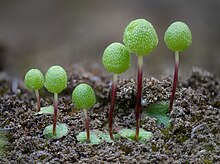| Asterella palmeri | |
|---|---|

| |
| Baja California, Mexico, 2024 | |
| Scientific classification | |
| Kingdom: | Plantae |
| Division: | Marchantiophyta |
| Class: | Marchantiopsida |
| Order: | Marchantiales |
| Family: | Aytoniaceae |
| Genus: | Asterella |
| Species: | A. palmeri |
| Binomial name | |
| Asterella palmeri (Austin) Underw. | |
| Synonyms | |
|
Fimbriaria palmeri (Austin, 1875) | |
Asterella palmeri, also known as Palmer's asterella, is a species of liverwort native to southwestern North America that can be found growing between roughly 30° and 40° north latitude. The plant is found in the U.S. state of California as far north as Redding, and in the Mexican state of Baja California as far south as Punta Baja, as well as in the northwestern corner of U.S. state of New Mexico. According to California bryologists William T. Doyle and Raymond E. Stotler, Palmer's asterella is typically found around chaparral, conifers, and in oak woodland in "exposed to lightly shaded summer-dry soil; usually on gentle to steep slopes." This liverwort is usually found below 950 metres (3,120 ft) elevation, but in the southern Sierra Nevada can be found at up to 1,250 metres (4,100 ft) above sea level.
The holotype was collected by Dr. Edward Palmer on Guadalupe Island off the Pacific coast of Mexico in 1875. The range of A. palmeri overlaps somewhat with the range of Asterella californica. A. palmeri is morphologically most similar to A. saccata, A. muscicola and the East Asian species A. grollei.

References
- ^ Evans, Alexander W. (1920). "The North American Species of Asterella". Contributions from the United States National Herbarium. 20 (8): I–VIII. JSTOR 23492237.
- ^ "Palmer's asterella (Asterella palmeri)". iNaturalist. Retrieved 2024-03-05.
- ^ Hong, Won Shic (Winter 1987). "The Distribution of Western North American Hepaticae. Endemic Taxa and Taxa with a North Pacific Arc Distribution". The Bryologist. 90 (4): 344–361. doi:10.2307/3243096. JSTOR 3243096.
- "NatureServe Explorer 2.0". explorer.natureserve.org. Retrieved 2024-03-05.
- "Liverworts of New Mexico: A Preliminary List" (PDF).
- ^ Doyle, William T.; Stotler, Raymond E. (2006). "Contributions Toward a Bryoflora of California Iii. Keys and Annotated Species Catalogue for Liverworts and Hornworts". Madroño. 53 (2): 89–197. doi:10.3120/0024-9637(2006)53[89:CTABOC]2.0.CO;2. ISSN 0024-9637. JSTOR 41425643. S2CID 86109963.
- Howe, Marshall A. (1899). The Hepaticae and Anthocerotes of California. Columbia University. pp. 54–55.
- Watson, Sereno (1875). "Botanical Contributions: On the Flora of Guadalupe Island, Lower California; List of a Collection of Plants from Guadalupe Island, Made by Dr. Edward Palmer, with His Notes upon Them; Descriptions of New Species of Plants, Chiefly Californian, with Revisions of Certain Genera". Proceedings of the American Academy of Arts and Sciences. 11: 105–148. doi:10.2307/20021459. ISSN 0199-9818. JSTOR 20021459.
- Long, David G. (Summer 1999). "Studies on the Genus Asterella. IV. Asterella grollei sp. nov., a New Species from Eastern Asia Related to the American A. palmeri". The Bryologist. 102 (2): 169–178. doi:10.2307/3244357. JSTOR 3244357.
| Taxon identifiers | |
|---|---|
| Asterella palmeri | |
| Fimbraria palmeri | |
This bryophyte-related article is a stub. You can help Misplaced Pages by expanding it. |